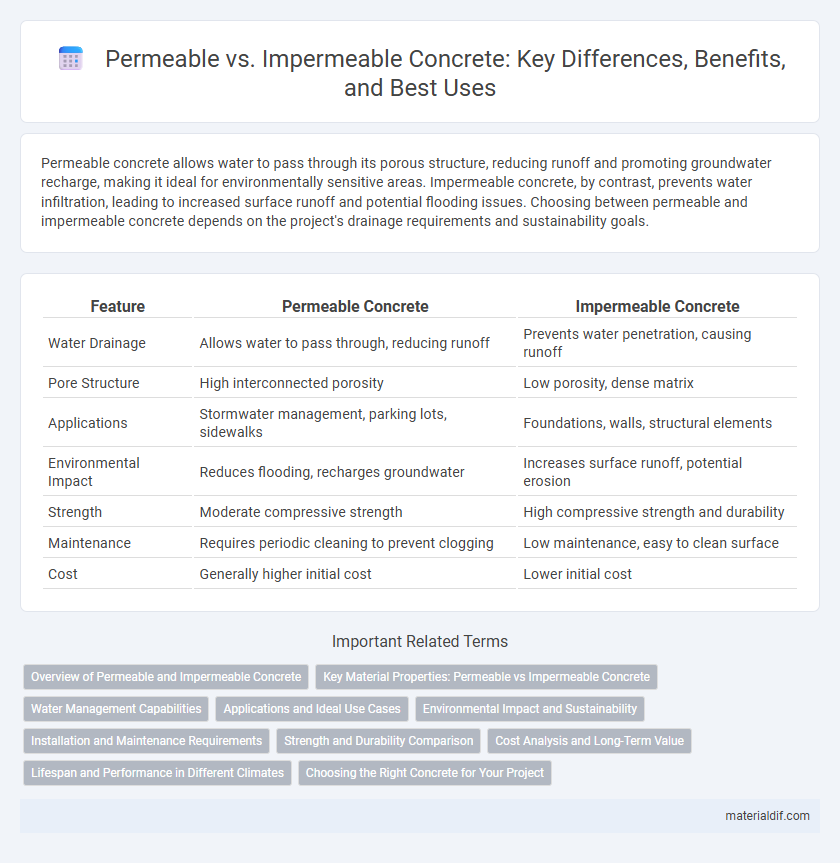Permeable concrete allows water to pass through its porous structure, reducing runoff and promoting groundwater recharge, making it ideal for environmentally sensitive areas. Impermeable concrete, by contrast, prevents water infiltration, leading to increased surface runoff and potential flooding issues. Choosing between permeable and impermeable concrete depends on the project's drainage requirements and sustainability goals.
Table of Comparison
| Feature | Permeable Concrete | Impermeable Concrete |
|---|---|---|
| Water Drainage | Allows water to pass through, reducing runoff | Prevents water penetration, causing runoff |
| Pore Structure | High interconnected porosity | Low porosity, dense matrix |
| Applications | Stormwater management, parking lots, sidewalks | Foundations, walls, structural elements |
| Environmental Impact | Reduces flooding, recharges groundwater | Increases surface runoff, potential erosion |
| Strength | Moderate compressive strength | High compressive strength and durability |
| Maintenance | Requires periodic cleaning to prevent clogging | Low maintenance, easy to clean surface |
| Cost | Generally higher initial cost | Lower initial cost |
Overview of Permeable and Impermeable Concrete
Permeable concrete, designed with higher porosity, allows water to pass through its surface, reducing runoff and promoting groundwater recharge, making it ideal for sustainable urban drainage systems. Impermeable concrete, with its dense and non-porous structure, prevents water infiltration, providing durability and strength for foundations and structural elements exposed to moisture. Understanding their distinct properties helps optimize concrete selection for specific environmental and structural requirements.
Key Material Properties: Permeable vs Impermeable Concrete
Permeable concrete features high porosity and allows water to pass through its matrix, making it essential for stormwater management and reducing runoff. Impermeable concrete, characterized by low porosity and dense composition, prevents water penetration and enhances durability in structures exposed to moisture. The key material properties influencing performance include aggregate size, water-cement ratio, and admixtures that affect permeability and strength.
Water Management Capabilities
Permeable concrete enhances water management by allowing rainwater to pass through its pores, reducing surface runoff and promoting groundwater recharge. Impermeable concrete prevents water infiltration, increasing the risk of flooding and water accumulation on surfaces. The choice between these concretes significantly impacts urban drainage systems and sustainable water management practices.
Applications and Ideal Use Cases
Permeable concrete is ideal for applications requiring effective stormwater management, such as parking lots, pedestrian walkways, and low-traffic roadways, where its ability to allow water infiltration reduces runoff and prevents flooding. Impermeable concrete suits structural elements like foundations, bridges, and buildings where water resistance is critical to maintain strength and prevent damage from moisture exposure. Selecting between permeable and impermeable concrete depends on balancing drainage needs with durability requirements in specific environmental conditions.
Environmental Impact and Sustainability
Permeable concrete significantly reduces stormwater runoff by allowing water to infiltrate the ground, which helps recharge groundwater and decrease pollution in urban areas. Impermeable concrete creates surface runoff that can lead to water pollution, flooding, and erosion, negatively impacting local ecosystems. By promoting natural water cycles and reducing the urban heat island effect, permeable concrete enhances environmental sustainability and supports eco-friendly infrastructure development.
Installation and Maintenance Requirements
Permeable concrete requires specialized installation techniques including proper subgrade preparation and precise aggregate gradation to ensure effective water infiltration, while impermeable concrete demands thorough compaction and curing to prevent water penetration and enhance durability. Maintenance for permeable concrete involves regular cleaning to prevent clogging of pores and ensuring consistent permeability, whereas impermeable concrete maintenance focuses on sealing cracks and surface treatments to maintain water resistance and structural integrity. Both types necessitate adherence to specific installation protocols and maintenance schedules to optimize performance and longevity in their respective applications.
Strength and Durability Comparison
Permeable concrete typically exhibits lower compressive strength, ranging from 2000 to 4000 psi, compared to impermeable concrete, which often exceeds 4000 psi due to its dense aggregate matrix. The porous structure of permeable concrete enhances water drainage but makes it more susceptible to freeze-thaw cycles and abrasion, potentially reducing long-term durability in harsh environments. In contrast, impermeable concrete's dense composition offers superior resistance to weathering, chemical attacks, and mechanical wear, making it ideal for high-strength, durable structural applications.
Cost Analysis and Long-Term Value
Permeable concrete often has higher initial installation costs due to specialized materials and construction techniques compared to impermeable concrete. However, permeable concrete reduces expenses related to stormwater management, surface runoff control, and potential regulatory fines over time. The long-term value of permeable concrete is enhanced by decreased maintenance costs, improved groundwater recharge, and environmental compliance benefits, making it a cost-effective solution in sustainable infrastructure projects.
Lifespan and Performance in Different Climates
Permeable concrete offers enhanced durability in regions with frequent freeze-thaw cycles by allowing water to drain, reducing freeze-related damage, while impermeable concrete can suffer cracking and deterioration under such conditions. In arid climates, impermeable concrete may perform better due to its reduced porosity, resisting dust infiltration and minimizing moisture loss, thereby extending its lifespan. Lifespan differences hinge on environmental exposure, with permeable concrete generally lasting 30 to 50 years in temperate zones and impermeable variants sometimes exceeding 50 years in dry, stable climates.
Choosing the Right Concrete for Your Project
Permeable concrete enhances stormwater management by allowing water to pass through its porous structure, reducing runoff and mitigating flooding risks in urban applications. Impermeable concrete offers superior strength and durability, making it ideal for structural foundations and areas requiring resistance to water infiltration. Selecting the right concrete involves assessing project requirements for drainage, load-bearing capacity, and environmental impact to balance functionality and sustainability.
Permeable Concrete vs Impermeable Concrete Infographic

 materialdif.com
materialdif.com